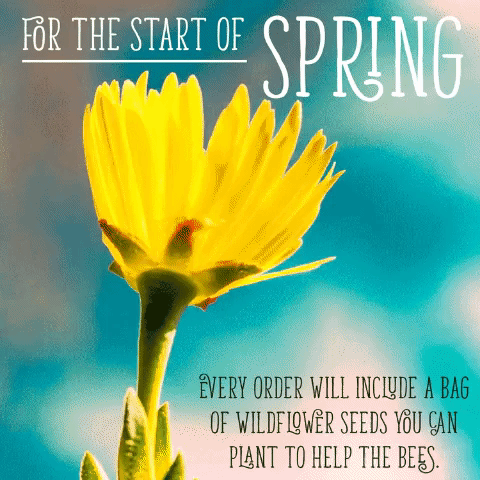Spring is a beautiful time to start helping our hurting honeybee population by planting some fresh pollen-rich flowers. Whether you want to make a seasonal bee-friendly habitat with a vibrant mix of spring and summer annuals, or plan to count on some hardy perennials to do the work for you, here are some fun varieties to start with:

Sunflowers (helianthus annuus, annual)
Bees can’t get enough of the massive bright yellow, gold or orange blooms on these classic annuals. What’s fun about sunflowers is they come in lots of surprising varieties, so you can experiment with dwarf-size “Little Beckas” or go to the extreme with “Big Smiles,” which can grow up to 2 feet tall.
Purple Coneflower (chinacea pallida, perennial)
The purple or pale purple varieties of echinacea purpurea are a perennial favorite among honeybees. The purple-pink daisy flowers begin blooming in summer and can continue even into the fall as long as you regularly pluck off the old flowers. Coneflower is also a seed producer, so birds benefit too.
Blackeyed Susan (rudbeckia, annual or perennial)
Bees and other pollinators are naturally drawn to the dramatic combination—bold yellow with black centers—on this North American native. This flower type is easily to grow and establishes quickly, as long as you give them a sunny spot to flourish. Blackeyed Susans will even thrive in dry areas or poor soil. Mix it up with varieties in beautiful bronze, red, mahogany, red or ones with two-tone petals.
The list is vast for flowers that bees will buzz about. Try these, too:
- Blue giant hyssop
- Common yarrow
- Horsemint
- Breadseed poppy
- Portulaca
- Blue anise sage

A free way to start a backyard bee habitat today
To make your job even easier, Nectar has partnered with American Meadows to send customers a free packet of wildflowers with every online purchase. It’s a simple way we can all start to make an impact in reversing our declining honeybee population.
The 100% pure, non-GMO and neonicotinoid-free Honey Bee Wildflower Mix seeds are guaranteed to grow. The packet features 19 nectar-rich wildflowers and clovers, and the flowers are easy to grow across much of the country (zones 1-8).
The pollinator-friendly mix includes 12 annual varieties like Lacy Phacelia and Yellow Prairie Coneflower for quick, first-season blooms, and seven perennial wildflowers like Mexican Hat and Echinacea for years of lasting color in the seasons to follow.
Once you get your pack, follow these instructions:
Plan:
- Check for your last frost date and plant after this has passed.
- Choose a spot on your property that gets 6 or more hours of direct sun a day (unless you are planting our Partial Shade Mixture).
- Prepare your soil by clearing the area of all existing growth. Simply dig up everything that is growing, turn the soil and rake the area flat. If this is an area that has never before been gardened, you may need to till the area up to remove growth.
Plant:
- Mix the seeds with sand for better visibility and scatter the seedsdirectly on top of the soil. If you are sowing a larger area, we recommend using a seed spreader; if not, you can sow by hand.
- We recommend lightly compressing the seeds into the soil, making sure not to bury them. You can either walk on them, use a board or if you are sowing a larger area, rent a seed roller.
Grow:
- Water so that the soil is moist, not soaking wet, until the seedlingsare about 4-6" tall. After that, the seedlings will survive on natural rains. If you are experiencing very dry weather, we recommend watering occasionally.

Wondering how to get your first free wildflower packet? Shop online right now for spring favorites like the polarized Lucia, Arctic or Disco.



